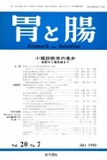Japanese
English
- 有料閲覧
- Abstract 文献概要
- 1ページ目 Look Inside
- サイト内被引用 Cited by
要旨 従来,小腸の内視鏡とX線検査は別々の日に行っていたが,われわれが考案した内視鏡および造影同時併用法によれば,一体化した単一の検査として施行できるので,患者にとっては苦痛ある前処置が1回で済む.また,検査術者にとっては,造影用long tubeの挿管が容易なので,X線被曝線量の減少を期待できる.更に,従来の方法によってはX線検査が困難であった部位(回腸,Billroth-Ⅱ法術後あるいは癌や潰瘍などによる幽門狭窄症例の十二指腸,結腸回腸側々吻合部から肛側の回腸)においても,造影用long tubeの挿管が可能となった.特に回腸では造影剤と空気量の調節が容易であり,腸管係蹄の重なりも少ないので,良好な二重造影像が得られた.
Previously, endoscopy and roentgenologic examinations of the small intestine have been performed on separate days. Now a method we have developed for endoscopic intubation of a long tube has enabled us to perform both examinations on the same day. Therefore, while this method reduces the frequency of preliminary treatments which are painful to the patient, since the method simplifies the intubation of a contrast tube, it also shortens greatly the length of time spent for the examination. These two benefits aid both the patient and the examining doctor. Also, by previous methods, it was impossible to intubate a contrasting tube to the duodenum, when the pyloric ring was contracted, or to the terminal ileum. However, with this method doctors are now able to intubate those parts of the intestine.
This method, combined endoscopic and roentgenologic survey, was tried in 50 patients in the duodenum and jejunum, and we have obtained good results (98%) except one patient during whose examination the tube came off. Also we have tried this method in 84 cases in the ileum. Among these in only three patients were we unable to insert the colonofiberscope into the jejunum during examination. We have obtained good results of double contrast radiograph in the jejunum by this method in 57 (83%) out of 69 patients. Reasons for these positive results are that there was enough air, that barium was injected directly into the jejunum, and that the barium did not change in quality. Furthermore, the number of cases where there was difficulty identifying the double contrast radiograph was reduced due to limited overlapping of intestinal loops. With the long tube designed for contrast radiologic examination we have developed, the barium and air neither leaked nor returned to the stomach or the cecum. The patients therefore are relieved of unnecessary and excessive abdominal distention.

Copyright © 1985, Igaku-Shoin Ltd. All rights reserved.


